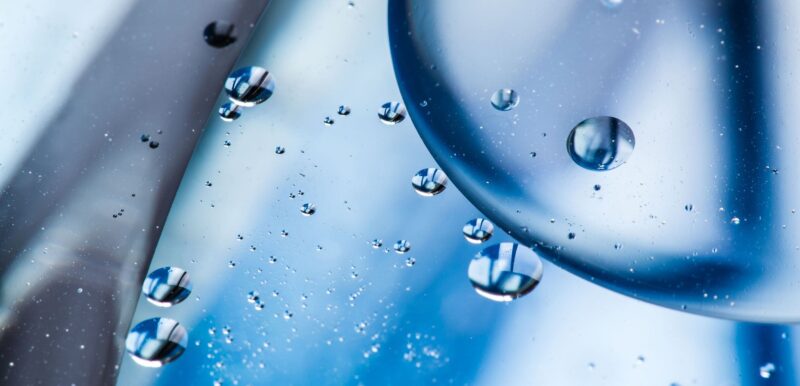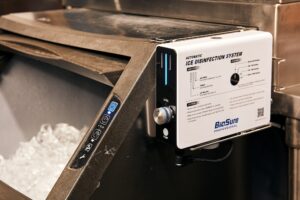For over a hundred years, ozone has been used as a sanitizing solution to sanitize water and water lines. We now can create this natural sanitizing solution on a micro-scale making available to anyone. But there is still misinformation about the safety of ozone water.

Have you noticed that fresh and clean odor in the air after a thunderstorm? That’s the smell of ozone. When oxygen takes on a third oxygen atom it becomes O3 or ozone. Just like nature makes ozone through electricity, we can also add an electrical charge to water to make ozone water, or ozonated water, usually done through an electrolytic ozone generator.
How Ozonation Works
Water ozonation is a chemical water treatment technique based on the infusion of ozone into water. Ozone is a gas composed of three oxygen atoms (O3), which is one of the most powerful oxidants. Ozonation is a type of advanced oxidation process involving the production of very reactive oxygen species able to attack a wide range of organic compounds and all microorganisms.
The treatment of water with ozone has a wide range of applications, as it is efficient for disinfection as well as for the degradation of organic and inorganic pollutants. Ozone is produced with the use of energy by subjecting oxygen (O2) to high electric voltage or to UV radiation. The required amounts of ozone can be produced at the point of use but the production requires a lot of energy and is therefore costly.
Water ozonation is a chemical process in which the chemical ozone (O3) is dissolved into a body of water. O3 will typically break apart within milliseconds and what is left behind is oxygen.
Using an ozonated water system, a stream of water is electrically charged. This charge in the water allows the ozone to form. Next, the ozonated water is pumped into the target water supply. As the ozone passes through the water, it will begin to break down into oxygen. There are two types of electrolytic generators: proton exchange membrane and direct. They each have specific applications and differ from the corona discharge method of creating ozone.
Substances that the oxide atoms will react with include iron, manganese, and hydrogen sulfide. Ozone is also very effective in eliminating biological matter in the water like bacteria or viruses. After the chemical ionization is finished, the water then goes through a post-filtration process to remove any particulate matter that was created in the process. The final water supply is then completely free of impurities. That means it is ready for use in a number of applications in the medical, dental, and food sanitation industries among others.
Is ozone water safe?
In fact, ozonation has been proven to be safer and more effective than chlorination for water treatment. The process has been approved by the US FDA since 2001, and it’s the preferred method for purifying, food-processing and bottling across a range of industries to kill bacteria and viruses, and without leaving chemical residues as chlorine does.
Because of the unstable nature of the O3 molecule, we don’t need to worry about any residual dangers from the ozonation process. There is also no effect of the process on a water’s pH balance. Because oxidation can be completed in such a short amount of time, the process remains fully within the safety limits outlined by the Occupational Safety and Health Administration (OSHA) guidelines. After the breakdown of the ozone and the diffusion of the oxide atoms, a process which takes only milliseconds, there are no lingering ozone molecules. The only things created by the process are newly recycled oxygen molecules and particulate matter formed by the oxide atoms.
US Government Approval of Ozone
Ozone water has received a number of certifications by governing bodies. In 2001, the US FDA approved ozonated water as an Antimicrobial Agent for Direct Contact With Food of all types (Federal Register 66(123):33829-33830, June 26, 2001). In the early 1980s, the FDA approved ozone as a disinfectant for bottled water and as a sanitizer for bottled water processing lines. In 1999, the US FDA turned over its responsibilities for “sanitizers” to the US EPA, and EPA refers to ozone as a “sanitizer” for direct contact with food and for disinfection of commercial food processing equipment.
The fact that ozone does not leave any chemical residues as chlorination does makes ozone a preferred method for disinfection by more and more business owners who want to leave a lighter touch on the environment in their daily operations. There are numerous cost benefits over the long term to ozone sanitation systems, leading ozone to become more widely adopted by dentists, hospitality, food and beverage, and commercial cleaning and laundry industries.
Conclusion
Ozone has gone through a long and arduous path to approval. However, now more business owners and individuals are enjoying the benefits of ozonated water in providing safer food products and healthcare services, among other applications, while cutting down on the cost of both chemical costs and hiring crews to apply complex chemical solutions.
The Earth is thankful as well, as ozone leaves no chemical byproducts and simply converts back to oxygen. As ozone emerges back into the spotlight as a known virus killer during the global COVID pandemic, this technology will become more commonplace in even more industries as a first and last line of defense in keeping us safe and healthy.
Copyright besgroups.com All Rights Reserved
Related Articles
Your Questions on Ozone Water Answered



